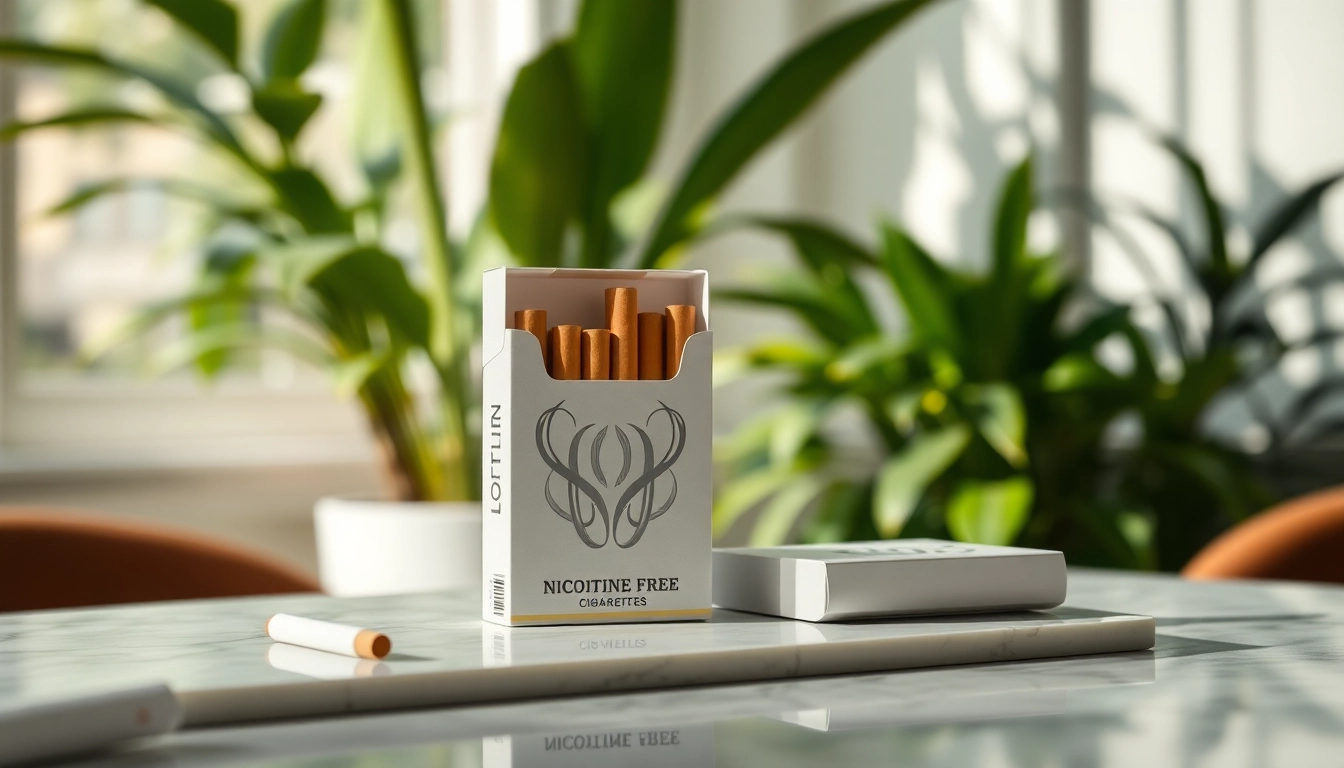

Reimagining Smoking: The Rise of Nicotine Free Cigarettes
1. Understanding Nicotine Free Cigarettes
1.1 What Are Nicotine Free Cigarettes?
Nicotine free cigarettes are designed to mimic the experience of traditional smoking without the addictive properties of nicotine. Typically, these products are made from a blend of herbs, plants, and sometimes artificial flavors. They appeal to smokers looking to reduce their dependence on nicotine, as well as individuals who enjoy the act of smoking without the chemical dependency associated with tobacco products. By using various botanical ingredients, these cigarettes often create a similar hand-feel, draw, and taste that casual or former smokers expect.
1.2 Benefits of Choosing Nicotine Free Options
The primary advantage of opting for nicotine free cigarettes is the elimination of nicotine addiction. Users can enjoy the ritualistic aspects of smoking without the associated cravings and withdrawal symptoms encountered while trying to quit traditional tobacco. Furthermore, nicotine free options often have fewer harmful ingredients and may present reduced health risks. Individuals who switch to these products can also experience various benefits such as decreased anxiety around smoking, improved lung function, and fewer instances of coughing. Moreover, many users report an enhanced ability to socialize without the stigma associated with traditional smoking.
1.3 Common Misconceptions and Myths
Despite their advantages, there are numerous misconceptions surrounding nicotine free cigarettes. A common myth is that they are entirely safe to consume; while they are less harmful than traditional cigarettes, they are not without risks. Another misconception is that users will not experience any cravings; some individuals may still feel certain habitual urges tied to the act of smoking. Understanding these nuances is crucial for individuals considering the transition to nicotine free products.
2. The Health Impacts of Smoking Alternatives
2.1 Comparing Health Risks: Traditional vs. Nicotine Free Cigarettes
When comparing traditional cigarettes to nicotine free alternatives, it is essential to look at the broader spectrum of health implications. Traditional cigarettes contain thousands of harmful chemicals, many of which are carcinogenic. In contrast, nicotine free cigarettes typically contain fewer toxins, offering a less hazardous smoking experience. While smoking anything carries risks, studies suggest that individuals may face substantially diminished health risks by switching to nicotine free products, although they should still aim to quit entirely for optimum health benefits.
2.2 Psychological Aspects of Switching
Switching from traditional smoking to nicotine free alternatives can be a complex psychological journey. Individuals may face challenges such as maintaining the routine of smoking without the substance that triggers addiction. Nevertheless, the psychological aspect of this transition can be assisted with behavioral strategies like mindfulness, distraction techniques, and guided assistance from counselors specializing in smoking cessation. An understanding of psychological triggers can empower individuals to navigate their relationship with smoking more effectively.
2.3 Real-Life Stories of Transitioning to Smoke-Free Products
Numerous testimonials illustrate the effectiveness of nicotine free cigarettes in aiding the transition away from traditional smoking. For example, one user recounted their journey from a pack-a-day habit to successfully switching to nicotine-free products. Over time, they noted not only an improvement in their physical health but also a change in their social environment as friends and family embraced their transition. Such stories can inspire others considering the switch and reinforce the sense of community among those on the same path.
3. Choosing the Right Nicotine Free Cigarettes for You
3.1 Factors to Consider when Selecting a Brand
When seeking out nicotine free cigarettes, several factors should be evaluated to determine the right brand for you. First, consider the ingredients included in the cigarettes—opting for brands that utilize natural herbs and organic materials can lead to a more pleasant and less harmful experience. Understanding the reputation of the brand and its commitment to quality and safety is also crucial. Reviews, brand transparency, and customer service are important indicators that can help guide your choice.
3.2 Flavor and Experience: What to Expect
Flavor profiles can vary significantly between various nicotine free cigarette brands. Some may offer a range of flavor options, from classic tobacco to fruity or herbal blends. It’s advisable to sample different flavors to find what suits your palate best. Additionally, users should expect a different mouthfeel and draw compared to traditional cigarettes. Experimenting with various brands will further inform your personal preference for flavor and overall smoking experience.
3.3 Evaluating Ingredients: Understanding Labels
A critical step in selecting the right nicotine free cigarettes is analyzing the ingredients on the product labels. Some brands may include additives that could diminish the product’s overall perceived safety. It’s important to choose options that clearly disclose their ingredients and avoid those with synthetic chemicals or vague terms. Knowledge of what you are consuming elevates control over your choices and contributes to an informed smoking experience.
4. The Market Landscape for Nicotine Free Cigarettes
4.1 Current Trends in the Smoke-Free Market
As the demand for healthier alternatives to traditional smoking continues to rise, the market for nicotine free cigarettes is experiencing significant growth. Current trends indicate a leaning towards organic products and natural blends as consumers become more health-conscious. Innovations such as CBD-infused options are also gaining traction, providing relaxation benefits while maintaining a smoke-free experience. Awareness campaigns about the health risks of traditional smoking are further propelling this shift towards nicotine-free alternatives.
4.2 Key Players and Brand Comparisons
Several key players dominate the nicotine free cigarette market. Brands such as Calm Puffs and other emerging companies are focusing on unique blends that cater to diverse consumer tastes. Comparing brands involves assessing their ingredient quality, pricing, product variety, and customer feedback. Industry reports suggest that consumer preferences are steering newer brands to express their unique selling propositions clearly, reflecting an evolving market landscape that caters to informed consumers.
4.3 Future Outlook: Innovations and Opportunities
The future of the nicotine free cigarette market looks promising, with increasing innovations likely to emerge as technology and consumer insights evolve. Advances in manufacturing methods will likely enable the creation of products that more closely replicate the traditional smoking experience while maintaining nicotine-free formulations. Opportunities also exist within online retail and subscriptions services, which can further enhance the accessibility and convenience of nicotine-free options for consumers.
5. Making the Transition: Practical Tips and Resources
5.1 Developing a Smoking Cessation Plan
Crafting an effective smoking cessation plan is paramount for those transitioning to nicotine free cigarettes. This plan should outline specific goals, timelines, and methods for monitoring progress. Setting realistic expectations can mitigate feelings of discouragement while ensuring that individual milestones are recognized and celebrated.
5.2 Community Support and Online Resources
Joining online forums and community groups can be beneficial for individuals making this transition. Support systems provide opportunities to share experiences, gain insights from others, and receive encouragement. Websites, books, and workshops dedicated to smoking cessation offer additional resources and strategies that can reinforce one’s commitment to quitting. Engaging in community events related to smoking cessation can provide motivation and foster a sense of camaraderie among participants.
5.3 Monitoring Progress: Adjusting Your Approach
Regularly evaluating your progress while transitioning to nicotine free options is vital to sustaining motivation and determining if adjustments are needed. Keeping a journal to track cravings, triggers, and overall satisfaction can yield valuable insights. If struggling with cravings, it may be useful to adjust your approach by trying different brands or flavors, or incorporating alternative stress-relief techniques such as physical exercise or deep-breathing exercises.

Understanding the Elegance of Vietnamese Áo Dài: Tradition and Fashion in Harmony
The Cultural Significance of Vietnamese Áo Dài
Historical Background
The Vietnamese Áo Dài, a traditional garment characterized by its elegance and modesty, has a long and rich history that dates back several centuries. Its origins trace back to the 18th century during the reign of the Nguyễn Dynasty, where it began as a simplified version of the Chinese dress called the “chai.” Initially worn by both men and women, the Áo Dài underwent several transformations, adapting to the cultural and aesthetic preferences of the Vietnamese people over time.
By the early 20th century, the Áo Dài took on its more recognizable form, especially among women. It became a symbol of Vietnamese identity, blending influences from French colonial fashion with traditional Vietnamese color and fabric choices. This shift reflected the social changes of the era, where women began to assert their independence while retaining their cultural heritage. The Vietnamese Áo Dài became distinct not only in style but also as a means of cultural expression in a rapidly changing world.
Symbolism in Vietnamese Identity
The Áo Dài is more than just a piece of clothing; it embodies the Vietnamese spirit and national pride. In many social and cultural contexts, the Áo Dài symbolizes femininity, grace, and traditional values. Its sleek and form-fitting silhouette accentuates the wearer’s elegance, making it a favored choice for occasions ranging from weddings to national celebrations.
Moreover, the color of the Áo Dài often holds special meanings. For instance, red is commonly worn during lunar new year celebrations as it symbolizes luck and prosperity, while white is preferred for funerals, symbolizing mourning and respect. As such, the Áo Dài plays a pivotal role in not just personal expression, but also in the socio-cultural tapestry of Vietnam, representing the connection between events and collective identity.
Regional Variations of Áo Dài
Across Vietnam’s diverse regions, the Áo Dài exhibits a variety of designs, patterns, and colors, influenced by local customs, climates, and artistic traditions. In the north, traditional designs often feature intricate embroidery and lighter fabrics suitable for the cooler climate. Regionally, the styles may encompass elements such as more conservative cuts and muted tones.
Conversely, southern regions, particularly cities like Ho Chi Minh City, showcase bolder colors and patterns, reflecting the vibrance of the tropical climate. Here, the designs often incorporate floral patterns and vivid hues, appealing to the modern flair of contemporary trends while honoring tradition. This regional diversity enriches the cultural significance of the Áo Dài, illustrating how local resources and aesthetics shape national identity.
Traditional Vietnamese Áo Dài Styles
Classic Designs and Modern Interpretations
Classic Áo Dài styles are synonymous with simplicity and elegance. Traditionally, the design features long sleeves and a long tunic that flares from the waist, allowing ease of movement without sacrificing modesty. As fashion evolves, designers have begun to reinterpret the classic styles to appeal to modern sensibilities. Innovations have included the incorporation of asymmetric cuts, unique collar designs, and varied lengths to suit different body types and personal preferences.
Today, fashion houses are experimenting with mixed materials, including silk, lace, and even denim. This blending not only showcases individualistic style but also keeps the traditional garment relevant. The result is a refreshing take on the Áo Dài that appeals to younger generations while honoring the traditional roots of the attire.
Materials Used in Áo Dài and Their Importance
The materials chosen for crafting an Áo Dài significantly influence its appearance and functionality. Traditionally, silk has been the fabric of choice due to its luxurious feel and visual appeal. However, other materials such as satin, brocade, and even cotton are often utilized for practicality and comfort, especially in different climates.
Color and pattern selection play equally important roles; the fabric’s sheen and texture can affect how colors are perceived. For instance, deep shades on silk can appear regal and sophisticated, while lighter fabrics may present a more casual aesthetic. This variety allows wearers to select Áo Dài that align with the occasion, personal style, and cultural significance.
Cultural Events and Festivals Featuring Áo Dài
The Áo Dài is prominently featured in Vietnamese cultural events and festivals. One of the most notable is Tết Nguyên Đán, the Vietnamese Lunar New Year, where wearing an Áo Dài symbolizes good luck and prosperity for the year ahead. Festivals celebrating the harvest and local heritage also see the Áo Dài adorning participants, emphasizing its role in communal identity and cultural heritage.
Besides traditional celebrations, the Áo Dài is gaining recognition on international platforms such as fashion weeks and cultural exhibitions, promoting Vietnamese heritage globally and fostering a deeper appreciation for its cultural significance.
How to Choose the Perfect Áo Dài for You
Understanding Fit and Fabric
Choosing the ideal Áo Dài starts with understanding fit and fabric. Traditional Áo Dài is designed to complement the wearer’s figure, enhancing natural curves while providing comfort. When selecting an Áo Dài, one should consider body shape and size; a well-fitted tunic should nip at the waist and flow gracefully to the hem. Seeking the expertise of a tailor can ensure that the garment is tailored to specific measurements, improving both comfort and aesthetics.
In terms of fabric, opting for breathable materials like silk or cotton is advisable for warm climates, whereas heavier fabrics may be suitable for formal occasions in cooler weather. This careful selection contributes to the overall appearance and comfort of the outfit.
Choosing Colors and Patterns
When selecting colors and patterns for an Áo Dài, it is essential to consider personal style and the significance of colors within Vietnamese culture. Popular choices include vibrant reds and pinks for celebrations, serene greens for casual wear, and muted pastels for more formal events. Patterns can range from traditional floral motifs to contemporary graphic designs, allowing for self-expression while respecting cultural heritage.
Individuals should also consider their skin tone and how certain colors enhance it. This thoughtful approach to color selection can elevate the overall look while ensuring that the Áo Dài remains a meaningful part of one’s wardrobe.
Accessorizing Your Áo Dài
Accessories play a crucial role in completing the Áo Dài ensemble. Traditional accessories include conical hats, jewelry, and silk scarves, which add layers of sophistication and cultural depth. The choice of accessories should complement the design of the Áo Dài without overshadowing its elegance. For instance, simple pearl earrings can enhance a classic silk Áo Dài, whereas colorful bangles may brighten a more contemporary design.
Additionally, handbags can be selected for both function and style, ensuring they match the overall color scheme while being practical for the occasion. Overall, with proper accessorizing, the Áo Dài can transition seamlessly from formal to casual settings.
Caring for Your Vietnamese Áo Dài
Washing and Maintenance Tips
Proper care is essential for preserving the beauty and longevity of your Áo Dài. Silk, for instance, requires delicate handling. It is advisable to hand wash silk Áo Dài in cold water with mild detergent, avoiding wringing to prevent damage. For other fabrics, always refer to care labels for appropriate washing instructions.
Regular maintenance, such as ironing and steaming, is also crucial for keeping the garment looking fresh and crisp. When storing your Áo Dài, avoid folding it in ways that can create permanent creases, and consider using padded hangers or fabric covers to protect the fabric from dust and damage.
Storage Techniques for Longevity
Proper storage techniques can significantly extend the life of your Áo Dài. It is ideal to hang the garment in a cool, dry place away from direct sunlight, which can fade colors over time. Using breathable garment bags can protect the fabric from dust while allowing it to breathe.
For long-term storage, avoid using plastic covers as they can trap humidity, leading to mold and mildew. Instead, opt for cotton or muslin wraps that protect the garment while allowing air circulation.
Repairing and Altering Áo Dài
No matter how well-maintained, wear and tear can inevitably affect your Áo Dài. For minor repairs, such as loose seams or small rips, consulting a professional tailor is always recommended to ensure that repairs match the original craftsmanship.
Alterations may also be needed as body shapes change over time. Regular fittings can ensure that the Áo Dài remains flattering and comfortable. If the design is a newer interpretation, consider collaborating with modern seamstresses who can enhance the garment’s aesthetics while staying true to its traditional roots.
The Future of Vietnamese Áo Dài in Global Fashion
Influence of International Trends
The global fashion landscape continues to evolve, leading to the integration of traditional garments like the Áo Dài within contemporary styles. International designers are increasingly inspired by the intricate designs and cultural richness of the Áo Dài. Collaborations between local Vietnamese designers and international fashion houses are becoming more common, helping to bring the elegance of the Áo Dài onto global runways and fashion events.
This crossover not only promotes cultural appreciation but also empowers local artisans and keeps traditional craftsmanship alive. Thus, the Áo Dài no longer serves only as a cultural artifact but as a vibrant participant within the broader dialogue of global fashion.
Sustainability and Ethical Practices
As sustainability becomes a key focus within the fashion industry, the future of the Áo Dài is also steering towards eco-friendly practices. Many Vietnamese designers are advocating for sustainable materials and production methods, promoting awareness of environmental impact while preserving cultural heritage. By utilizing organic fabrics and ethical labor practices, they are creating a more sustainable fashion ecosystem for future generations.
This evolving approach to production not only appeals to environmentally conscious consumers but also positions the Áo Dài as a modern symbol of sustainable fashion rooted in tradition.
Modern Designers Promoting Áo Dài
Several contemporary designers are redefining the Áo Dài, infusing modern interpretations while retaining its cultural significance. Designers like Võ Công Khanh and Nguyễn Công Trí are at the forefront of this movement, showcasing their collections at prestigious events and gaining recognition for their innovative takes on traditional attire.
These modern renditions continue to challenge conventional aesthetics while attracting a younger audience, celebrating the Áo Dài’s legacy while paving the way for future adaptations. Their work not only honors tradition but ensures the Áo Dài’s relevance in today’s fashion narrative.










